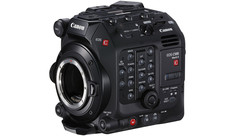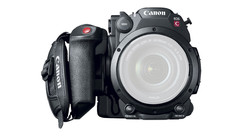The biggest difference you see right away is the sensor size. The C200 has a Super 35 sensor, while the C700 FF is a full frame sensor. The size difference between the sensors are almost exactly a lens length – for example, if you place the two cameras side by side, put a 35mm on the Full Frame camera and a 24mm lens on the Super 35 camera, you will get almost exactly the same image. I say almost because there will be subtle differences in dimension and in perspective – the wider the lens, the more distortion and the lower the possible F stop. I was actually expecting much more distortion on the wider lenses on the C200, but it was optically very similar because the Super 35 sensor is only taking the middle of the lens – plus, most distortion and vignetting occur on the fringes of the lens.
There isn’t that much difference between a 50mm and a 80mm in terms of optical quality, but there is a noticeable difference between a 24mm and 20mm, and a 20mm and 14mm is extreme. Shallow focus is hard on wider lenses and once you get past 18mm you no longer get fast T1.5 lenses, it drops to T3.1 at 14mm. You can almost always move closer to your subject, but you can’t always move back further – there’s usually a wall or street in the way. So full frame sensors will have the advantage in terms of lens and shot selection.
The next biggest physically difference is how the camera is laid out. You can see Canon’s DSLR background in the design of the C200/C300 range, right down to the eyepiece/EVF. Just like a DSLR, the C200 is designed to be operated by a single user, with all of the buttons on the same side as the user. On a set, this means that to adjust a setting on the camera, you have to stop shooting, put the camera down, make the change and then pick it back up. The C700, with screens on either side, lets an operator busy themselves with the business of shooting, while an AC/focus puller on the other side of the camera does what they need to do, like ajust settings and change cards. The operator could even keep shooting while the AC changes out cards, as in a long interview or something similar.
There are also a lot of format advantages for the C700, which make it a more versatile camera. It can shoot compressed MP4, like the C200 does, and it can output high end RAW, again like the C200 does internally. The real difference is the middle ground – the goldilocks codecs like ProRes 422, which are the most advantageous for broadcast applications like TV and documentary. Unlike the C200, the C700 has a ton of options.
To test the key concepts of usability and versatility, we shot a short film with same lenses and the same lighting on both the C700 and C200 in my studio. One caveat is that we shot the internal raw on C200, but didn’t have the external RAW module for the C700. Instead, we shot with the internal ProRes 444 codec in 4K. That said, we’re uploading this in 1080p, so you shouldn’t see much of a difference. The reason the C700 needs the codex module for RAW is that the full frame sensor records in 5.9K at a data rate of 5.8Gbps, which is well beyond the top data rate of the CFast cards.
Image-wise, the two takes were very similar. Both had the same dynamic range and color depth, and we didn’t see any smoking gun in terms of moving from the Full Frame to the Super 35 sensor. The C200 was lighter and quicker to move between setups, but the C700 needed less takes and is a much more integrated unit. There is less chance of failure because you’re using systems that were made to work together. I also think the camera movement on the C700 was smoother, probably because the camera weights 5x as much.
We were shooting in a small space, but it wasn’t a tiny space, in which case the C700 and the Full Frame sensor would have been a huge advantage. We were also shooting with plenty of light and the slower speeds of the wider 18mm and 14mm lenses, which the S35 sensor needs to match the 24mm of the Full Frame, didn’t get us into trouble – but its easy to see how in a night shoot they would have.
In conclusion, for a single operator, run-and-gun or gimbal work, the C200 is a clear winner. It's designed for that purpose. The C700 on the other hand, is designed for a DP/operator, plus a focus puller/AC and a 2nd AC. A team like this can work far faster and get shots that would be hard if not impossible for a single operator. On a show where time is money that efficience can easily be the difference between making your day and not making your day. Over a 30 day shoot, it's easy with the price difference between hiring these two. If I was shooting a feature film tomorrow, I could have the C700 FF as a A camera and the C200 on a Steadicam or gimbal as a go-to B camera, knowing that footage from the two will cut together seamlessly.












